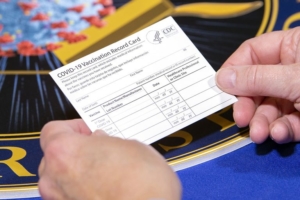
By Sally Greenberg, NCL Executive Director
It’s almost a miracle. We now have safe and effective vaccines to fight SARS CoV2, commonly known as COVID-19, the devastating illness that has swept across the globe and—as of January 16, 2021—has killed more than 390,938 Americans and infected 23.5 million in less than a year.
Nearly 40 percent of those who’ve died were beloved older Americans in long-term care facilities, where the disease spread like wildfire, and who were often unable to say goodbye to loved ones.
Sadly, many who contracted the illness and survived spent lengthy hospital stays clinging to life on respirators. Of those who recovered, millions report COVID’s debilitating long-term effects. The United States has four percent of the world’s population but nearly a fifth of its recorded coronavirus deaths—the most of any country. Think of this: we have lost in less than one year eight times the number of Americans who died in the whole Vietnam war, and nine times the number who die in car accidents each year.
But now there’s light at the end of the tunnel because, in record time, America’s pharmaceutical companies have successfully developed safe and highly effective vaccines. Since the SARS CoV 2’s grip over America in late March of 2020, all medical experts could talk about—beyond washing hands, wearing masks, and social distancing—was getting a vaccine to prevent this illness. But vaccines typically take many years to develop so, we were told, don’t hold your breath. And yet here we are.
Consumer groups and members of Congress have been known to criticize the pharmaceutical industry. I get it; too many drugs are expensive and out of reach for millions of Americans, and that must be addressed. But it’s also important to acknowledge value of the public private partnership and the vast resources these companies have put into the R&D and bringing to market life-saving vaccines.
The COVID-19 pandemic is a prime example. The leading vaccines developed for COVID-19 are here, thanks to the dedication of industry leaders and scientists. Pfizer CEO Albert Bourla shifted the company’s focus to singlemindedly developing a COVID vaccine, leveraging its substantial scientific and medical expertise, as well as 20 years of research on previous SARS-like illnesses. Pfizer committed hundreds of millions of dollars of its own resources to building a manufacturing network, and companies agreed to share their knowhow. These efforts were critical in achieving an effective and safe vaccine in record time. And in creating a distribution system that could maintain the very cold temperatures needed to preserve, especially the Pfizer vaccine, before it is administered.
Our government doesn’t have the resources to make that happen alone. Yes, something close to $10 billion in taxpayer dollars through Operation Warp Speed went to companies to assist with the rapid development of a vaccine, but Pfizer didn’t accept government funding for the initial development of the vaccine (though the company did receive $1.95 billion for manufacturing and nationwide distribution of 100 million doses).
And now we have Moderna, which also received more than $1 billion in funding, joining Pfizer in making available a two-dose vaccine that is safe and 95 percent effective, with Johnson & Johnson, Merck, and Novavax not far behind with vaccines that may only require one dose. The public-private partnership model works. And consumers won’t have to pay to receive these shots. Experts tell us we should have five vaccines available by March or April, which is important because it gives healthcare providers options for different populations.
The next challenge is getting it into the arms of enough of us so that we can reach herd immunity, which means at least 60-70 percent of the population needs to be vaccinated.
And while this process has been disappointingly slow, this is largely because states haven’t been given adequate resources from the federal government to support a massive vaccination program. That said, more than a million Americans and counting have now been vaccinated and, under the incoming Biden-Harris Administration and a Democratic Congress, vast additional resources will be going to support for states and localities. The good news for vaccines is that there is high demand for the shots. My own Washington, DC community has offered thousands of appointments for shots online in the morning and they are taken immediately.
We have many to thank for this vaccine’s rapid development, but we must acknowledge the success of this uniquely American public-private partnership. We applaud the heroic work of Pfizer, Moderna, and the other companies to speed R&D and clinical trials of thousands of patients, to ensure a vaccine that is safe and effective. And kudos also to the trusted scientists at FDA and CDC for reviewing the data, ensuring the safety and efficacy of the vaccines, and approving them.
A special thanks is due to two esteemed FDA directors: former director Dr. Scott Gottlieb and our current FDA head Dr. Stephen Hahn, who gave us the straight scoop this past year and promised and delivered on FDA’s integrity and reliance on science throughout the process. And of course, we owe a deep debt of gratitude to our national hero, Dr. Anthony Fauci, who provided honest, science-based advice to the American people throughout these tense and trying times, despite pressure from the Trump Administration to play down the pandemic. Americans clearly agree, as evidenced by “Thank You, Dr. Fauci” signs on lawns across America!




 By Nailah John, Program Associate
By Nailah John, Program Associate



 By NCL Director of Health Policy Jeanette Contreras
By NCL Director of Health Policy Jeanette Contreras









